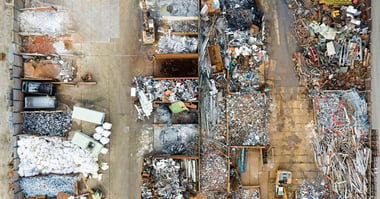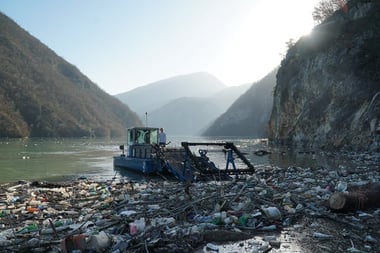As the world population grows, so does the amount of waste we produce. The World Bank predicts that, unless we act now, the annual global waste output will increase by 70% by 2050.
Managing trash correctly is crucial, helping to keep our planet’s ecosystems healthy, safe, and sanitary. From recycling to co-processing, there are loads of waste management systems — but some are more effective than others.
There’s even a waste management hierarchy that categorizes these practices on their environmental impact. A lot of factors influence the ways we manage waste. So, let’s unpack them.
Want to fund waste management projects in vulnerable areas? At CleanHub, we’re committed to helping brands reduce their plastic footprint and work toward a more circular economy. All you have to do is get in touch to get the ball rolling.
What’s on this page?
01 | The waste management hierarchy02 | The different types of waste management
03 | New waste management innovations and solutions
04 | Summary
The waste management hierarchy
Waste can be broken down into various categories to determine how best to manage it. This can vary, depending on biodegradability, toxicity, and where the waste comes from.
When simplified, waste tends to fall into one of these five categories:
- Organic waste: Items that can decompose naturally, like food
- Recyclable waste: Trash made from certain plastics, glass, paper, and metals that can be repurposed
- Liquid waste: Wastewater, chemicals, and oils released from houses and industry
- Solid waste: General household items like clothing, packaging, and goods
- Hazardous waste: Dangerous and toxic materials often found in things like batteries and medical waste
The most common forms of waste management focus on affordability, quickly putting waste out of sight (and out of mind). This is happening all over the world.
More than 80% of municipal plastic waste in the United States was sent straight to landfills, and recycling levels throughout the nation have reportedly “stagnated.”
There must be a better way to deal with this waste.
Zero Waste Europe (ZWE) created a waste management hierarchy that explores the best ways to save resources and address this issue.
1. Reduce: Cut down on the initial resources needed to lessen eventual waste2. Reuse: Prolong a product’s lifespan to get the most out of the material
3. Recycle: Turn waste into new products as part of an effective circular economy model
4. Recovery: Use waste to generate energy, extracting value from it that can’t be repurposed
5. Landfill: A last resort for waste disposal, safely ensuring it’s contained and doesn’t leak into the environment
The different types of waste management
In a standard dictionary, waste is described as something “no longer useful or required after the completion of a process.”
However, the waste management hierarchy shows us that this description isn’t entirely accurate. Many materials can have other uses if we know how to handle them.
Here are the most popular strategies:
1. Recycling
Recycling is when waste materials are turned into other products that can be reused.
It’s a practice humans have been doing throughout history, with the earliest known instances dating back to 400 BC in the Roman period.
It’s also one of the most impactful ways to support a circular economy, keeping materials in circulation instead of disposing of them and exporting others.
Recycling requires collection, sorting, processing, and remanufacturing and can work effectively for some plastics, paper, glass, and metal — though the process and requirements vary.
The benefits are enormous: one ton of recycled plastic can conserve over 3,000 liters of oil and dramatically reduce emissions linked to climate change.
However, setbacks have slowed progress. For instance, although over 75% of American waste is believed to be recyclable, households only send 32% to recycling.
Contamination is one of the biggest issues, as mixing materials during recycling can impact the results or even damage equipment. One report claims there is a 25% contamination rate on average, which may result in recyclables still being thrown away.
Cost is another significant factor. One US report claimed that landfilling one ton of trash cost around $28, while it costs $128 to recycle. Obviously, that doesn’t apply to every recycling initiative, but it points to a stark disparity that may hinder more interest in the practice.
Not only is recycling more expensive than landfill, but the price of recycled plastic is also rising.
With businesses and consumers still primarily driven by financial factors, the price of using recycled materials may still serve as a deterrent.
2. Waste-to-energy
Waste-to-energy (WtE) does what it says on the tin — it converts waste into energy like electricity or heat, helping to conserve energy in other areas while reducing waste.
Popular methods include co-processing, where organizations use combustion to turn waste into energy and raw materials.
This has proven particularly beneficial in the cement industry and is an effective way to deal with contaminated trash from recycling.
Other strategies include gasification, where waste is mixed with oxygen or steam to turn into fuel or fertilizer.
One report says WtE plants can reduce the volume of waste by up to 87%, so it's a good way to cut down on the amount of space taken up by garbage.
But it’s by no means a silver bullet, either.
The amount of carbon emissions linked to this practice varies depending on the material, but it’s still pretty high and contributes to climate change. According to Zero Waste Europe, the CO2 emissions related to WtE have doubled in the last ten years — mainly because the practice is being promoted and adopted by more organizations.
3. Composting
Composting is a biological process that naturally breaks down the organic matter in waste.
The subsequent compost product can be recycled back into the soil, reducing the need for fertilizers and cutting back methane emissions from landfills.
The world throws away 2.5 billion tons of food every year, so composting is one way to mitigate the negative impact.
Composting is limited to organic materials, so while beneficial, it doesn’t impact non-biodegradable waste (which still dominates our landfills).
There’s also little consumer incentive to get involved with composting schemes.
Around 97% of UK households don’t compost because they either don’t have access to a garden or have to pay extra for council-led green recycling schemes.
4. Incineration
Disposal incineration uses high temperatures to destroy waste in a furnace. It’s similar to waste-to-energy practices but it has fewer benefits because the energy isn’t repurposed.
This type of incineration reduces the volume of waste, but the environmental cost is pretty substantial as it releases carbon dioxide and harmful toxins into the environment.
While more countries are trying to focus on WtE practices instead of standard incineration, it’s still quite common.
For example, in 2018, 7.4 million tons of all UK waste was sent to a WtE plant, while another 7 million tons were incinerated.
An Unearthed investigation also found that incineration plants are disproportionately situated in low-income areas.
There aren’t a lot of up-to-date studies into the health impacts of living close to an incinerator facility, but experts believe it can lead to cancer risks, birth defects, and other health issues.
5. Landfill
Landfills are one of the most popular ways to dispose of waste, despite offering few benefits for the environment, resources, and human health.
It’s popular because some see it as a quick and ‘cost-effective’ way to manage waste. Indeed, it’s easier to dump garbage and forget about it than to build more recycling facilities.
However, our planet is paying the ultimate price.
There are over 3,000 official landfills in operation in the US and 10,000 closed landfills — both impacting the environment.
According to researchers at the University of Colorado, the nation has lost 1,800,000 acres of habitat to landfill space.
Waste in landfills also contributes to 11% of global methane emissions, meaning the trash continues to impact our air years after it is thrown away.
Leakage and pollution from these sites are common, so waste easily seeps into the surrounding environment and water systems — having a lasting impact on the natural landscapes.
There are thousands of landfill sites worldwide where mountains of trash are left to degrade. Some of these materials are toxic, while others can take centuries to break down. Fires can break out at landfill sites, leading to even more emissions and air pollution.
In rare cases, landfills are the only option for waste disposal. But most of the time, there are better solutions — perhaps some are yet even to be realized.
The more we support the ongoing reliance on landfills, the more opportunities we miss to recycle and reuse waste materials.
New waste management innovations and solutions
Technology is revolutionizing how we tackle global waste issues, with innovative solutions helping address plastic pollution and waste collection.
The Internet of Things, a new tech that relies on data exchange between objects, is increasingly leveraged in smart waste management systems.
This is just one way we can address the challenges facing the most common waste management systems, such as recycling contamination.
Bin-e is a smart waste bin that separates recycling once it’s thrown into the bin, removing the need for later sorting processes and helping reduce the risk of contamination.
Alternatively, CleanCUBE relies on solar power to compact trash and can hold up to 5 times more than a regular bin. This reduces waste volume and optimizes storage, offering environmental benefits while providing a more cost-effective solution for households in the long run.
Innovations like these make waste management smarter, more efficient, and more sustainable.
Summary
There’s a lot of space for waste management innovation that can help us make a cleaner world.
But that won’t work alone.
Sustainable technologies have to come alongside increased public awareness, financial incentives for clean businesses, and community-driven initiatives.
Governments will need to work with businesses and consumers, creating a multi-pronged approach to waste, packaging, and recycling. This starts through dialogue, consumer action, and a real demand for change.
By working toward a circular economy that prioritizes the most rewarding parts of the waste management hierarchy, we can reduce resource extraction, maximize reuse, and recycle efficiently. Together, we can stop waste from becoming waste in the first place.

.webp)
-3.png)


.webp?width=380&name=wave%20(1).webp)
.webp?width=380&name=Plastic-bales%20(1).webp)
.webp?width=380&name=CleanHub-waste-worker%20(1).webp)

.webp?width=380&name=CleanHub-waste-sorters-%20(1).webp)
.webp?width=380&name=Someone-recycling-waste%20(1).webp)

.webp?width=380&name=Recycling-plant%20(1).webp)
